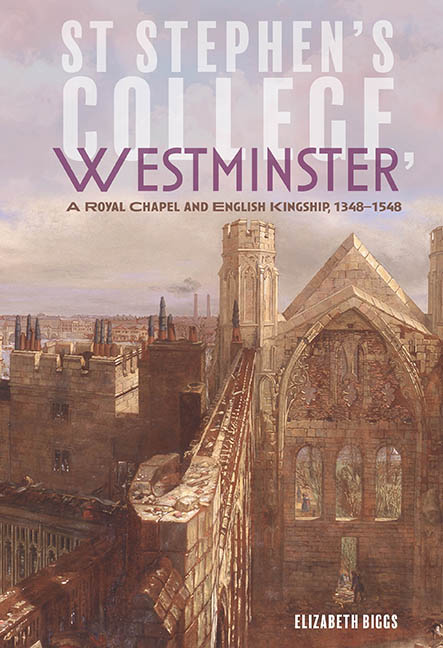Book contents
- Frontmatter
- Contents
- List of Illustrations
- Acknowledgements
- List of Abbreviations
- Preface
- Introduction
- 1 Finding a Place Within Westminster, 1348–1394
- 2 Magnificence and Difficulties under Richard II, 1377–1399
- 3 Weathering Political and Economic Storms, 1399–1485
- 4 A New Kind of Court? Display, Pageantry and Worship, 1471–1536
- 5 Responding to the Reformation, 1527–1548
- Conclusions
- Bibliography
- Index
- Miscellaneous Endmatter
- Frontmatter
- Contents
- List of Illustrations
- Acknowledgements
- List of Abbreviations
- Preface
- Introduction
- 1 Finding a Place Within Westminster, 1348–1394
- 2 Magnificence and Difficulties under Richard II, 1377–1399
- 3 Weathering Political and Economic Storms, 1399–1485
- 4 A New Kind of Court? Display, Pageantry and Worship, 1471–1536
- 5 Responding to the Reformation, 1527–1548
- Conclusions
- Bibliography
- Index
- Miscellaneous Endmatter
Summary
For two hundred years at any one time a group of twenty-six priests, four singing men, about six choristers, a verger and a keeper of the chapel of St Mary le Pew served the king's palace chapels of St Stephen, St Mary Undercroft and the oratory of St Mary le Pew within the Palace of Westminster. These men, who belonged to the royal college of St Stephen the Protomartyr, knew their role was to pray daily for the royal family, the dead who had asked to be commemorated in the chapel, and for the kingdom of England as a whole. Their prayers were expressed through the daily round of liturgy and music enjoined upon them by their own regulations, the statutes, which modified the common liturgical practice of the southern English Church, known as the Sarum Use. Their roles had been set by the college's founder, the English king Edward III, when in a letter patent dated 6 August 1348 he had commanded the foundation of the college ‘to the honour of God, St Stephen the Protomartyr, and the Virgin Mary’. On the same day he founded St George’s, Windsor, the home of the Order of the Garter. With modifications and a considerable increase in the numbers of people prayed for, the basic pattern set in 1348 was still true at Easter 1548, when another Edward, Edward VI, dissolved all remaining institutions that had as their primary purpose to pray for the dead in Purgatory, including St Stephen’s. St George's was exempted from that act. The twenty-six priests at both colleges were divided into two groups. The dean and the twelve canons were appointed by the king, and so were drawn from the world of royal service, where they also worked in the king's administration or his household and were in consequence rewarded with ecclesiastical positions at institutions with no parochial responsibilities. Their presence was expected at the main mass of the day and when otherwise required, but much of their time could be devoted to the work of administration and government in the Palace of Westminster, and they might have many other additional ecclesiastical posts.
- Type
- Chapter
- Information
- St Stephen s College WestminsterA Royal Chapel and English Kingship, 1348–1548, pp. 1 - 26Publisher: Boydell & BrewerPrint publication year: 2020



